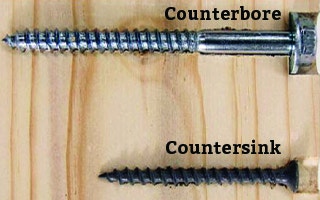Countersink vs. Counterbore Screw Holes - What's The Difference?
Counterbore and countersink screws are sometimes used interchangeably, but there is a difference in the shape and usage of the screws and holes they make. The key difference between countersink and counterbore screws are the size and shape of the holes, counterbore holes are wider and more square to allow for the addition of washers. Counterboring is a means of setting a fastener below the surface of the workpiece, just like countersinking.
Although the terms are sometimes used interchangeably, the main difference lies in the shape of the bottom of the hole. Countersinking creates a conical hole matching the angled shape on the underside of a flat-head screw.
This conical hole can be shallow, with the screw resting flush with the surface of the workpiece when driven in, or it can be made deep enough that a wood button or plug can be installed above the screw once it has been set at the bottom of the cone.
Counterboring creates a flat-bottom hole, which allows the head of a screw or bolt with a flat underside to rest solidly in the counterbore, often atop a washer. While the hole above a deeply set flat-head screw is usually the same size as the screw head, the hole created for a counterbore is typically larger than the head, which allows room for both the washer as well as the driving tool, such as a socket wrench.
Keep the inspiration coming!
Subscribe to our newsletter for more woodworking tips and tricks

